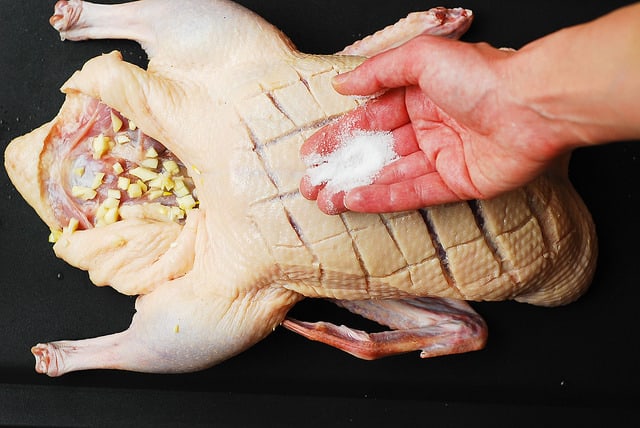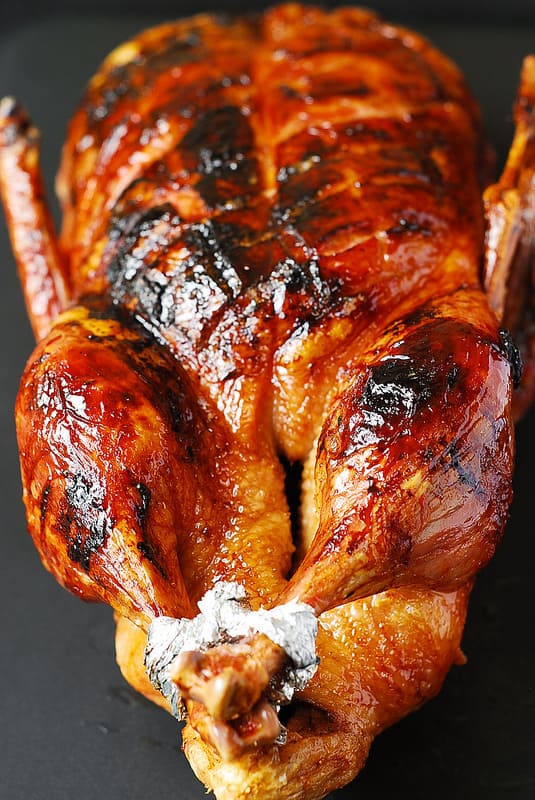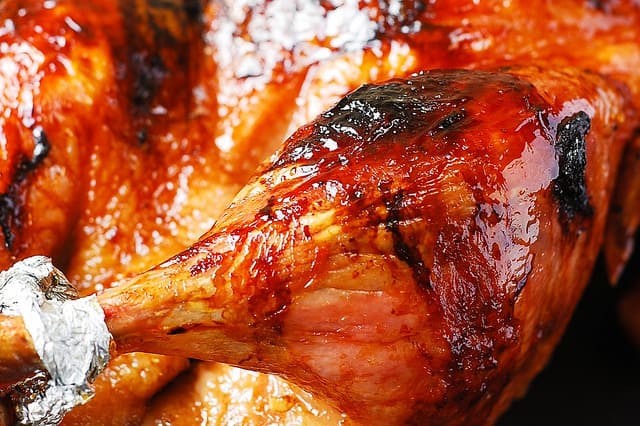Learn how to make Oven Roasted Whole Duck with this detailed, easy-to-follow recipe. This classic dish is perfect for holidays, dinner parties, or any time you want to impress your guests with something rich, flavorful, and beautifully presented. Roasting a duck may sound intimidating, but with the right steps, you can achieve golden, crispy skin and tender, juicy meat right in your home kitchen.
1. Oven Roasted Whole Duck Recipe
Ingredients
For the Roast Duck:
-
1 whole duck (5–6 pounds)
-
Salt (to taste)
-
5 garlic cloves, chopped
-
1 small or medium lemon, chopped
For the Glaze:
-
½ cup balsamic vinegar
-
1 lemon, freshly squeezed juice
-
¼ cup honey
Instructions
Step 1: Prepare the Duck
Thaw and clean the duck:
If your duck is frozen, let it thaw completely in the refrigerator for 24–48 hours. Once thawed, remove any giblets or excess fat from the cavity. Rinse the duck thoroughly under cold water, then pat it completely dry with paper towels — this is key for crispy skin.
Score the skin:
Using a sharp knife, gently score the duck’s breast skin in a crosshatch pattern. Be careful not to cut into the meat — only pierce the fat layer. This helps render out excess fat and makes the skin beautifully crisp during roasting.
Season generously:
Sprinkle salt all over the duck, including inside the cavity. Salt helps draw out moisture and enhances the flavor of the meat.

Stuff the cavity:
Fill the inside of the duck with the chopped garlic and lemon pieces. This adds aroma and keeps the meat juicy as it cooks.
Tie up the legs:
Using butcher’s twine, tie the duck’s legs together. This ensures even cooking and helps maintain the duck’s shape during roasting.

Step 2: Roast the Duck
Preheat the oven:
Preheat your oven to 375°F (190°C). Place a wire rack inside a roasting pan. The rack will allow the fat to drip off while keeping the duck elevated for even cooking.
Initial roasting:
Place the duck breast-side up on the rack. Roast uncovered for 1 hour and 15 minutes. During this time, the duck fat will start to render out, and the skin will begin to brown.
Drain excess fat:
After the first hour, carefully remove the pan from the oven and spoon out or pour off the excess fat (save it if you want to use it for roasting potatoes later — it’s delicious!).
Flip and continue roasting:
Turn the duck breast-side down and roast for another 45 minutes. This helps render fat from all sides and ensures the meat cooks evenly.
Flip back and apply glaze:
Meanwhile, prepare the glaze (see below). Flip the duck breast-side up again, brush it generously with the balsamic-honey glaze, and roast for an additional 15–20 minutes, or until the skin is deep golden brown and crisp.
Use a meat thermometer to check for doneness — the internal temperature should reach 165°F (74°C) at the thickest part of the thigh.

Step 3: Make the Glaze
Combine the ingredients:
In a small saucepan, mix together the balsamic vinegar, honey, and fresh lemon juice.
Simmer until thickened:
Place the saucepan over medium heat and simmer for about 8–10 minutes, stirring occasionally, until the glaze reduces slightly and becomes syrupy.
Brush and caramelize:
During the final roasting stage, brush the duck with this glaze several times to create a shiny, caramelized finish.
Step 4: Rest and Carve
Once the duck is fully cooked, remove it from the oven and let it rest for 15–20 minutes before carving. Resting allows the juices to redistribute throughout the meat, ensuring every slice is moist and flavorful.
To carve, cut along the joints to remove the legs and thighs first, then slice the breast meat. Serve with extra glaze drizzled over the top.
2. Tips for Perfect Oven Roasted Whole Duck
Dry the duck thoroughly:
The drier the skin, the crispier it becomes. You can even refrigerate the uncovered duck for several hours before roasting to air-dry the skin.
Score carefully:
Don’t pierce the meat when scoring; only cut through the skin and fat. This prevents the duck from drying out.
Use a rack:
A roasting rack helps air circulate around the duck, ensuring the bottom doesn’t become soggy in its own fat.
Save the duck fat:
Duck fat is liquid gold — use it for roasting vegetables or potatoes for incredible flavor.
Baste during roasting:
Brushing the duck with its rendered fat or glaze several times during cooking enhances both color and flavor.
3. Serving Suggestions
Oven roasted duck pairs beautifully with both savory and sweet sides. Here are a few delicious ideas:
Classic pairing: Serve with roasted potatoes cooked in duck fat and steamed green beans or asparagus.
Fruity twist: Duck and fruit are a perfect match — try serving with orange sauce, cranberry compote, or roasted apples.
Asian-inspired: Pair with hoisin sauce, scallion pancakes, or a side of jasmine rice and stir-fried vegetables.
Festive touch: For holiday dinners, serve with wild rice stuffing, glazed carrots, and a red wine reduction sauce.
A crisp white wine like Riesling or a fruity red like Pinot Noir complements the richness of duck beautifully.

4. Frequently Asked Questions
Q1: How do I know when my duck is done?
The duck is done when the internal temperature reaches 165°F (74°C) at the thickest part of the thigh. The juices should run clear, and the skin should be golden and crisp.
Q2: Can I prepare the duck in advance?
Yes! You can season and stuff the duck a day ahead, then refrigerate it uncovered overnight to dry the skin. This actually improves the crispiness when roasted.
Q3: What should I do with the leftover duck fat?
Save it! Strain and store duck fat in the refrigerator. It’s perfect for roasting potatoes, sautéing vegetables, or even frying eggs for incredible flavor.
Q4: How do I reheat leftover roasted duck?
Reheat slices of duck in a 350°F (175°C) oven for about 10 minutes, uncovered, to crisp the skin again. Avoid microwaving — it will make the skin soggy.
Q5: Can I use the same recipe for duck legs or breasts only?
Absolutely. Adjust the cooking time — roast duck breasts for about 25–30 minutes and legs for 40–45 minutes, depending on size. Keep the same glaze for that signature flavor.
Conclusion
Making Oven Roasted Whole Duck at home is easier than you might think. With simple ingredients, careful preparation, and the right technique, you can achieve restaurant-quality results right from your own oven. The combination of crispy golden skin, tender meat, and a tangy-sweet balsamic honey glaze makes this dish unforgettable.
